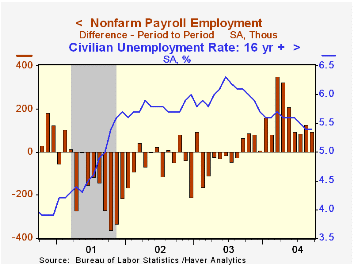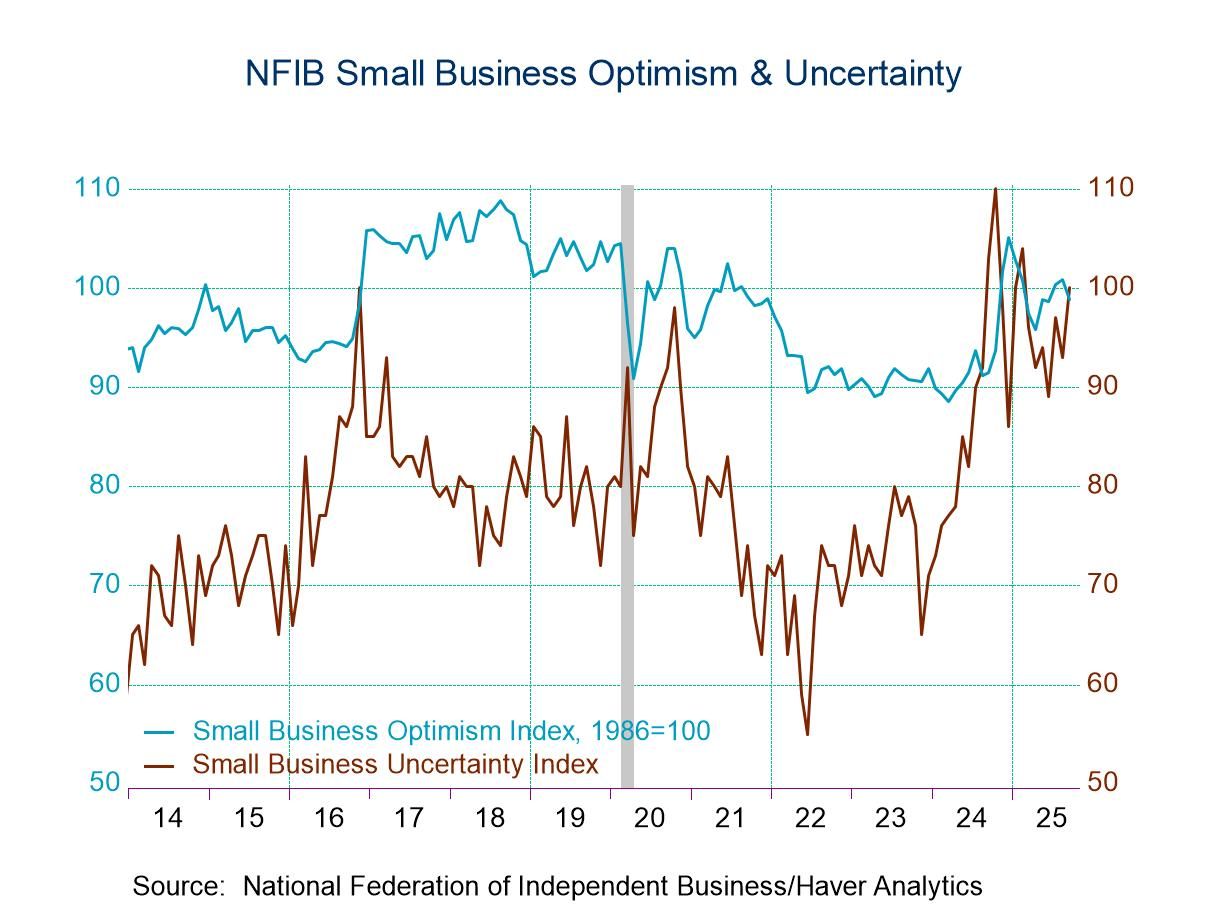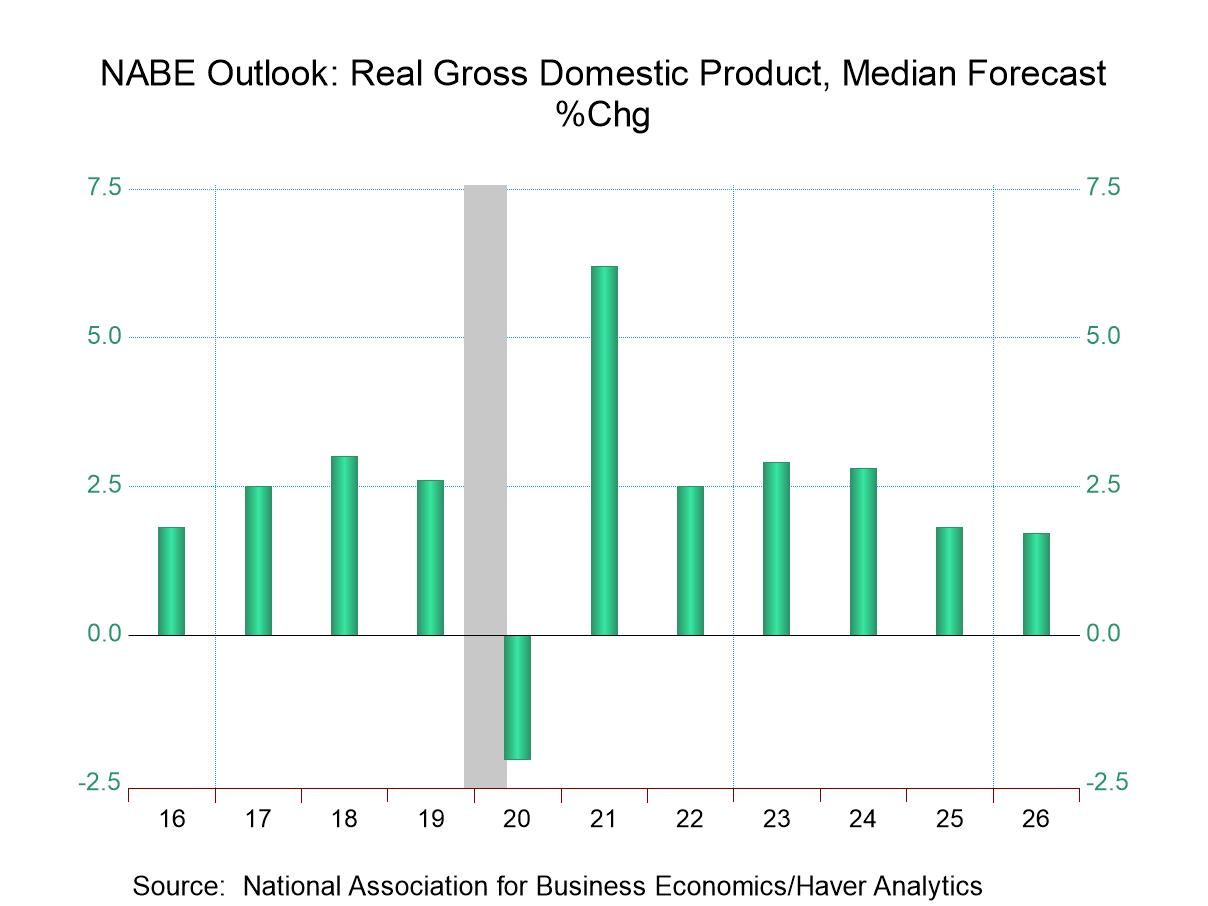 Global| Oct 08 2004
Global| Oct 08 2004U.S. Job Creation Disappointing in September, Hurricane Effects Small
by:Tom Moeller
|in:Economy in Brief
Summary
Nonfarm payrolls grew 96,000 last month following a downwardly revised 128,000 August increase. Consensus expectations had been for a 150,000 job gain in September. The four hurricanes which struck the US during August and September [...]

Nonfarm payrolls grew 96,000 last month following a downwardly revised 128,000 August increase. Consensus expectations had been for a 150,000 job gain in September.
The four hurricanes which struck the US during August and September were estimated to not have had a significant effect on job growth. Jobs lost due to severe weather were offset by hiring for recovery efforts.The employment report from the Bureau of Labor Statistics indicated that "At the national level, the severe weather appears to have held down employment growth, but not enough to change materially the Bureau's assessment of the employment situation in September."
Factory sector payrolls fell by 18,000 (+0.1% y/y), the first monthly decline since June. A moderate 0.1% (-1.7% y/y) fall in nondurable industries hiring reflected sharp declines in textile mills (-6.4% y/y) and apparel (-5.7% y/y), offset by gains elsewhere. Hiring in durable goods industries was down broadly, 0.1% m/m, but up 1.2% y/y. Construction sector hiring grew a modest 4,000 (2.6% y/y).
Hiring in private service producing industries rose a modest 72,000 (1.6% y/y). Jobs in the financial sector rose another 28,000 m/m (1.1% y/y). Hiring in professional & business services grew 34,000 (3.0% y/y) and temporary help services jobs grew 33,000 (9.6% y/y).
The index of aggregate hours worked (employment times hours worked) in September rose 0.1% (2.4% y/y) for the second consecutive month and in the third quarter grew 3.2% (AR) from 2Q.
Average hourly earnings rose 0.2% (2.4% y/y).
From the separate household survey, the unemployment rate held steady at 5.4%. Employment fell 201,000 (+1.3% y/y) but the labor force also fell by 221,000 (+0.6% y/y), the second consecutive down month, as the labor force participation rate slipped to 65.9%. The Labor Department indicated that "In the household survey, people who miss work for weather-related events are counted as employed whether or not they are paid for the time off."
| Employment | Sept | Aug | Y/Y | 2003 | 2002 | 2001 |
|---|---|---|---|---|---|---|
| Payroll Employment | 96,000 | 128,000 | 1.3% | -0.3% | -1.1% | 0.0% |
| Manufacturing | 18,000 | 4,000 | 0.1% | -4.8% | -7.2% | -4.8% |
| Average Weekly Hours | 33.8 | 33.8 | 33.6 | 33.7 | 33.8 | 34.0 |
| Average Hourly Earnings | 0.2% | 0.3% | 2.4% | 2.7% | 2.9% | 3.8% |
| Unemployment Rate | 5.4% | 5.4% | 6.1% | 6.0% | 5.8% | 4.8% |
Tom Moeller
AuthorMore in Author Profile »Prior to joining Haver Analytics in 2000, Mr. Moeller worked as the Economist at Chancellor Capital Management from 1985 to 1999. There, he developed comprehensive economic forecasts and interpreted economic data for equity and fixed income portfolio managers. Also at Chancellor, Mr. Moeller worked as an equity analyst and was responsible for researching and rating companies in the economically sensitive automobile and housing industries for investment in Chancellor’s equity portfolio. Prior to joining Chancellor, Mr. Moeller was an Economist at Citibank from 1979 to 1984. He also analyzed pricing behavior in the metals industry for the Council on Wage and Price Stability in Washington, D.C. In 1999, Mr. Moeller received the award for most accurate forecast from the Forecasters' Club of New York. From 1990 to 1992 he was President of the New York Association for Business Economists. Mr. Moeller earned an M.B.A. in Finance from Fordham University, where he graduated in 1987. He holds a Bachelor of Arts in Economics from George Washington University.






